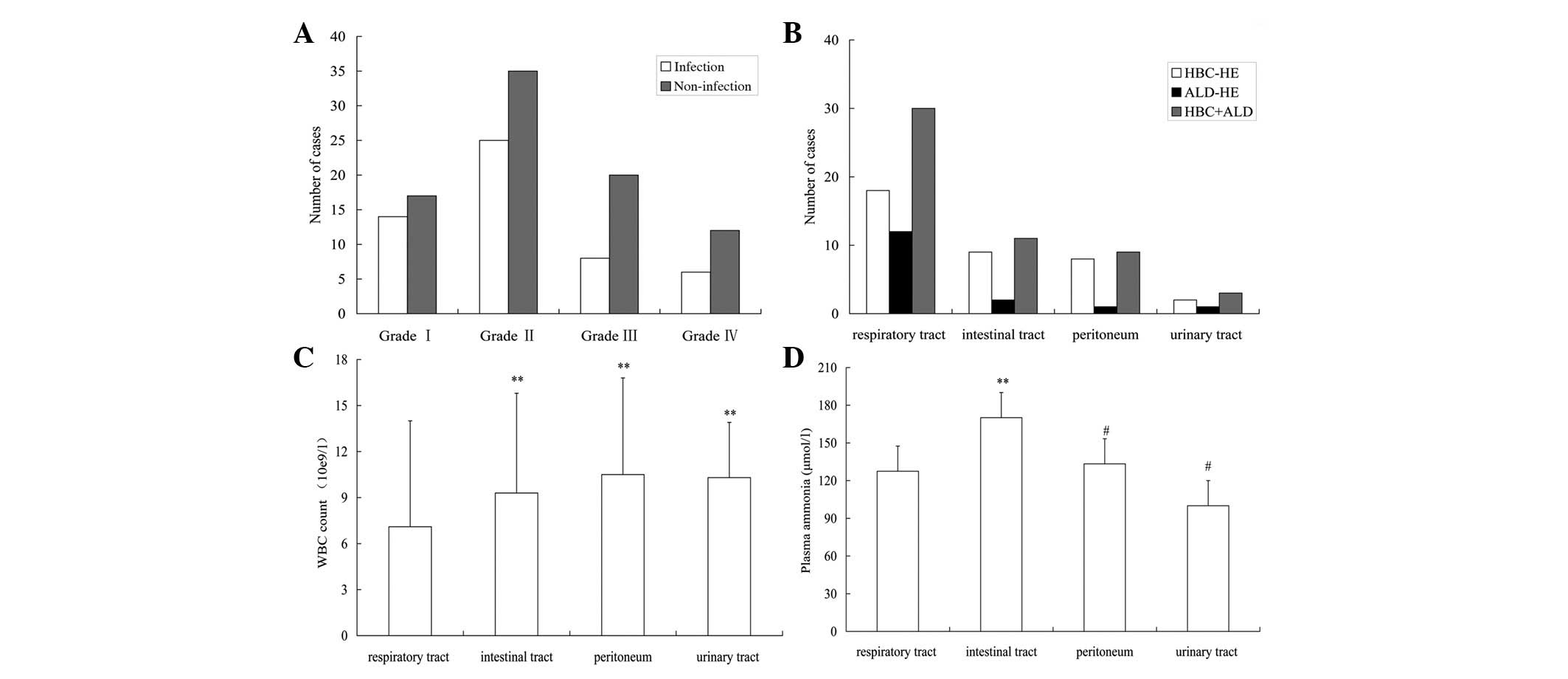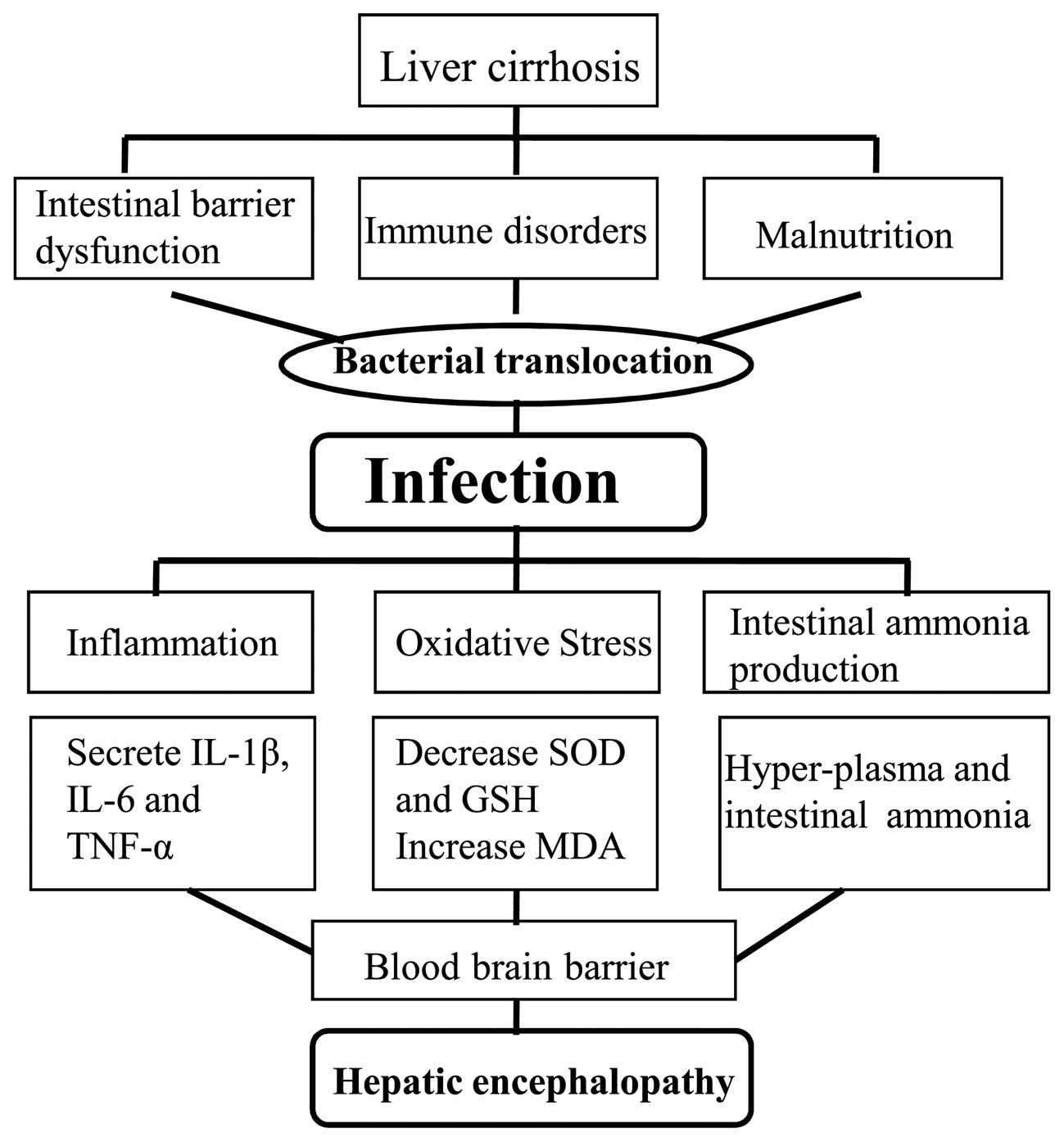|
1.
|
Ferenci P, Lockwood A, Mullen K, Tarter R,
Weissenborn K and Blei AT: Hepatic encephalopathy - definition,
nomenclature, diagnosis, and quantification: final report of the
working party at the 11th World Congresses of Gastroenterology,
Vienna, 1998. Hepatology. 35:716–721. 2002. View Article : Google Scholar
|
|
2.
|
Zhang FK, Zhang JY and Jia JD: Treatment
of patients with alcoholic liver disease. Hepatobiliary Pancreat
Dis Int. 4:12–17. 2005.PubMed/NCBI
|
|
3.
|
Häussinger D: Hepatic encephalopathy. Acta
Gastroenterol Belg. 73:457–464. 2010.
|
|
4.
|
Shawcross DL, Sharifi Y, Canavan JB, et
al: Infection and systemic inflammation, not ammonia, are
associated with Grade 3/4 hepatic encephalopathy, but not mortality
in cirrhosis. J Hepatol. 54:640–649. 2011. View Article : Google Scholar : PubMed/NCBI
|
|
5.
|
Bustamante J, Rimola A, Ventura PJ, et al:
Prognostic significance of hepatic encephalopathy in patients with
cirrhosis. J Hepatol. 30:890–895. 1999. View Article : Google Scholar : PubMed/NCBI
|
|
6.
|
Bellot P, Jara Pérez López N, Martínez
Moreno B and Such J: Current problems in the prevention and
treatment of infections in patients with cirrhosis. Gastroenterol
Hepatol. 33:729–740. 2010.(In Spanish).
|
|
7.
|
Zhuang J: 52 cases analysis of
precipitating factors in cirrhosis with hepatic encephalopathy. J
Clin Hepatol. 10:57–58. 2007.(In Chinese).
|
|
8.
|
Zhang M and Duan ZJ: Retrospective
analysis of factors influencing the development and progression of
hepatic encephalopathy in patients with hepatitis B virus related
cirrhosis. Shi Jie Hua Ren Xiao Hua Za Zhi. 20:1148–1155. 2012.(In
Chinese).
|
|
9.
|
O’Shea RS, Dasarathy S, McCullough AJ, et
al Practice Guideline Committee of the American Association for the
Study of Liver Diseases; Practice Parameters Committee of the
American College of Gastroenterology: Alcoholic liver disease.
Hepatology. 51:307–328. 2010.
|
|
10.
|
Papadopoulos N, Soultati A, Goritsas C, et
al: Nitric oxide, ammonia, and CRP levels in cirrhotic patients
with hepatic encephalopathy: is there a connection? J Clin
Gastroenterol. 44:713–719. 2010. View Article : Google Scholar : PubMed/NCBI
|
|
11.
|
Devrajani BR, Shah SZ, Devrajani T and
Kumar D: Precipitating factors of hepatic encephalopathy at a
tertiary care hospital Jamshoro, Hyderabad. J Pak Med Assoc.
59:683–686. 2009.PubMed/NCBI
|
|
12.
|
McAvoy HC and Hayes PC: Hepatic
encephalopathy. Medicine. 35:108–111. 2006. View Article : Google Scholar
|
|
13.
|
Häussinger D and Görg B: Interaction of
oxidative stress, astrocyte swelling and cerebral ammonia toxicity.
Curr Opin Clin Nutr Metab Care. 13:87–92. 2010.PubMed/NCBI
|
|
14.
|
Atluri DK, Prakash R and Mullen KD:
Pathogenesis, diagnosis, and treatment of hepatic encephalopathy. J
Clin Exp Hepatol. 1:77–86. 2011. View Article : Google Scholar
|
|
15.
|
Vaquero J, Polson J, Chung C, et al:
Infection and the progression of hepatic encephalopathy in acute
liver failure. Gastroenterology. 125:755–764. 2003. View Article : Google Scholar : PubMed/NCBI
|
|
16.
|
Licinio J and Wong ML: Pathways and
mechanisms for cytokine signaling of the central nervous system. J
Clin Invest. 100:2941–2947. 1997. View Article : Google Scholar : PubMed/NCBI
|
|
17.
|
Bémeur C, Desjardins P and Butterworth RF:
Antioxidant and anti-inflammatory effects of mild hypothermia in
the attenuation of liver injury due to azoxymethane toxicity in the
mouse. Metab Brain Dis. 25:23–29. 2010.PubMed/NCBI
|
|
18.
|
Cauli O, Rodrigo R, Piedrafita B, Llansola
M, Mansouri MT and Felipo V: Neuroinflammation contributes to
hypokinesia in rats with hepatic encephalopathy: ibuprofen restores
its motor activity. J Neurosci Res. 87:1369–1374. 2009. View Article : Google Scholar : PubMed/NCBI
|
|
19.
|
Rodrigo R, Cauli O, Gomez-Pinedo U, et al:
Hyperammonemia induces neuroinflammation that contributes to
cognitive impairment in rats with hepatic encephalopathy.
Gastroenterology. 139:675–684. 2010. View Article : Google Scholar : PubMed/NCBI
|
|
20.
|
Karvellas CJ, Pink F, McPhail M, et al:
Bacteremia, acute physiology and chronic health evaluation II and
modified end stage liver disease are independent predictors of
mortality in critically ill nontransplanted patients with
acute-on-chronic liver failure. Crit Care Med. 38:121–126.
2010.
|
|
21.
|
Shawcross DL, Olde Damink SW, Butterworth
RF and Jalan R: Ammonia and hepatic encephalopathy: the more things
change, the more they remain the same. Metab Brain Dis. 20:169–179.
2005. View Article : Google Scholar : PubMed/NCBI
|
|
22.
|
Cauli O, Rodrigo R, Piedrafita B, Boix J
and Felipo V: Inflammation and hepatic encephalopathy: ibuprofen
restores learning ability in rats with portacaval shunts.
Hepatology. 46:514–519. 2007. View Article : Google Scholar : PubMed/NCBI
|
|
23.
|
Shawcross DL, Davies NA, Williams R and
Jalan R: Systemic inflammatory response exacerbates the
neuropsychological effects of induced hyperammonemia in cirrhosis.
J Hepatol. 40:247–254. 2004. View Article : Google Scholar : PubMed/NCBI
|
|
24.
|
Blei AT: Infection, inflammation and
hepatic encephalopathy, synergism redefined. J Hepatol. 40:327–330.
2004. View Article : Google Scholar : PubMed/NCBI
|
|
25.
|
Shawcross DL, Wright G, Olde Damink SW and
Jalan R: Role of ammonia and inflammation in minimal hepatic
encephalopathy. Metab Brain Dis. 22:125–138. 2007. View Article : Google Scholar : PubMed/NCBI
|
|
26.
|
Sharifi Y, Canavan JB, Yeoman AD, et al:
Defining the outcome, precipitants and cost of severe hepatic
encephalopathy (HE) in cirrhosis. Hepatology. 48(Suppl):
1061A2008.
|
|
27.
|
Shawcross DL, Shabbir SS, Taylor NJ and
Hughes RD: Ammonia and the neutrophil in the pathogenesis of
hepatic encephalopathy in cirrhosis. Hepatology. 51:1062–1069.
2010. View Article : Google Scholar : PubMed/NCBI
|
|
28.
|
Shawcross DL, Wright GA, Stadlbauer V, et
al: Ammonia impairs neutrophil phagocytic function in liver
disease. Hepatology. 48:1202–1212. 2008. View Article : Google Scholar : PubMed/NCBI
|
|
29.
|
Wasmuth HE, Kunz D, Yagmur E, et al:
Patients with acute-on-chronic liver failure display ‘sepsis-like’
immune paralysis. J Hepatol. 42:195–201. 2005.
|
|
30.
|
Antoniades CG, Wendon J and Vergani D:
Paralysed monocytes in acute-on-chronic liver disease. J Hepatol.
42:163–165. 2005. View Article : Google Scholar : PubMed/NCBI
|
|
31.
|
Lin CY, Tsai IF, Ho YP, et al: Endotoxemia
contributes to the immune paralysis in patients with cirrhosis. J
Hepatol. 46:816–826. 2007. View Article : Google Scholar : PubMed/NCBI
|
|
32.
|
Rosa H, Silvério AO, Perini RF and Arruda
CB: Bacterial infection in cirrhotic patients and its relationship
with alcohol. Am J Gastroenterol. 95:1290–1293. 2000. View Article : Google Scholar : PubMed/NCBI
|
|
33.
|
Borzio M, Salerno F, Piantoni L, et al:
Bacterial infection in patients with advanced cirrhosis: a
multicentre prospective study. Dig Liver Dis. 33:41–48. 2001.
View Article : Google Scholar : PubMed/NCBI
|
|
34.
|
Wiest R and Rath HC: Gastrointestinal
disorders of the critically ill. Bacterial translocation in the
gut. Best Pract Res Clin Gastroenterol. 17:397–425. 2003.
View Article : Google Scholar : PubMed/NCBI
|
|
35.
|
Andreu M, Sola R, Sitges-Serra A, et al:
Risk factors for spontaneous bacterial peritonitis in cirrhotic
patients with ascites. Gastroenterology. 104:1133–1138.
1993.PubMed/NCBI
|
|
36.
|
Bernardi M: Spontaneous bacterial
peritonitis: from pathophysiology to prevention. Intern Emerg Med.
5(Suppl 1): S37–S44. 2010. View Article : Google Scholar : PubMed/NCBI
|
|
37.
|
Sigal SH: Hyponatremia in cirrhosis. J
Hosp Med. 7(Suppl 4): S14–S17. 2012. View
Article : Google Scholar
|
|
38.
|
Angeli P, Wong F, Watson H and Ginès P;
CAPPS Investigators: Hyponatremia in cirrhosis: Results of a
patient population survey. Hepatology. 44:1535–1542. 2006.
View Article : Google Scholar : PubMed/NCBI
|
|
39.
|
Häussinger D and Schliess F: Pathogenetic
mechanisms of hepatic encephalopathy. Gut. 57:1156–1165. 2008.
|
|
40.
|
Amodio P, Del Piccolo F, Pettenò E, et al:
Prevalence and prognostic value of quantified electroencephalogram
(EEG) alterations in cirrhotic patients. J Hepatol. 35:37–45. 2001.
View Article : Google Scholar : PubMed/NCBI
|
|
41.
|
Baccaro ME, Guevara M, Torre A, Arcos E,
Martin-Llahí M, Terra C, Gómez-Anson B, Rami L, Arroyo V and Ginès
P: Hyponatremia predisposes to hepatic encephalopathy in patients
with cirrhosis. Results of a prospective study with time-dependent
analysis. Hepatology. 44(Suppl 1): 233A2006.
|
|
42.
|
Fernández J, Navasa M, Gómez J, et al:
Bacterial infections in cirrhosis: epidemiological changes with
invasive procedures and norfloxacin prophylaxis. Hepatology.
35:140–148. 2002.PubMed/NCBI
|

















